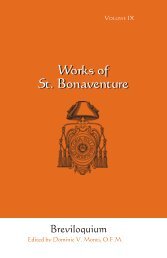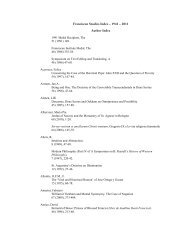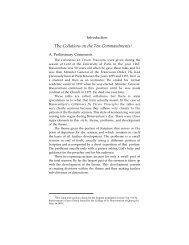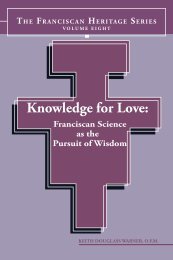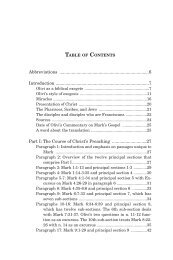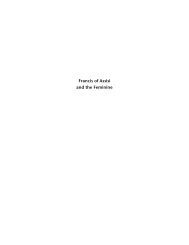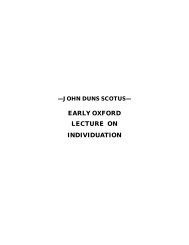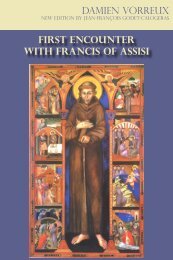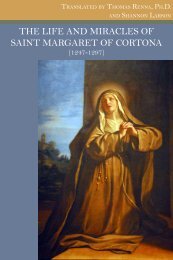FOUR QUESTIONS ON MARY - Franciscan Institute Publications
FOUR QUESTIONS ON MARY - Franciscan Institute Publications
FOUR QUESTIONS ON MARY - Franciscan Institute Publications
You also want an ePaper? Increase the reach of your titles
YUMPU automatically turns print PDFs into web optimized ePapers that Google loves.
John Duns Scotus: Four Questions on Mary<br />
in the decades that followed. 49 In the Ordinatio it is the only<br />
alternative to his own preferred position, and since this version<br />
is really Scotus’s own rather than Henry’s he does not<br />
even mention the “Ghentian” as he did in the earlier Lectura<br />
Completa. 50 Nevertheless, it is clear from all his accounts<br />
that Scotus himself chose to believe Mary never contracted<br />
sin to begin with, since he sees this as a distinct possibility<br />
and according to his Marian principle “If the authority of<br />
the Church or the authority of Scripture does not contradict<br />
such, it seems probable what is more excellent should be attributed<br />
to Mary.” And it is on this basis that he interprets<br />
the Feast of the Conception. 51<br />
49 This second possibility would become the preferred interpretation of<br />
those who wished to hold the common opinion, and did not feel comfortable<br />
with Scotus’s first possibility. Thus, the Dominican Durandus of Saint-<br />
Pourçain, writing a decade or more later, says: Hic est duplex modus dicendi.<br />
Primus est quod B.V. non fuit concepta in originali peccato, sed simul<br />
tempore fuit animata et grata ipsi data. Et huius dicti ostenditur primo<br />
possibilitas ... secundo congruitas ... et tertio probatur quod ita factum fuerit<br />
... Alius modus dicendi est quod ... non decuit ut praeservata fuerit. He<br />
also agrees this view does not rule out the fact that Christ was also Mary’s<br />
redeemer, but he then goes on to give his own opinion. His non obstantibus,<br />
[alia] opinio videtur verior, scilicet quod Deus potuit facere quod B. V. per<br />
solum instans esset in culpa originali et toto tempore sequenti in gratia...<br />
Sent. III, d. 3, q. 2 (Antverpiae, 1566), f. 218rb; q. 2, f. 218va.<br />
50 Scotus, Lectura completa (92). Referring to this second possibility he<br />
writes: Sed secundum etiam fuit possibile, scilicet quod tantum per unum<br />
instans fuit in peccato originali et in tempore habito in gratia. Et si sic intelligit<br />
Gandavus, tunc est opinio bona, ita quod pro instanti conceptionis<br />
fuerit in culpa et filia irae, et in tot tempore habito sub gratia, quia hoc<br />
patet in creaturis frequenter. According to the Krakow MS (Bibl. univer.<br />
Iagell., lat. 1408) a detailed account of what Henry really taught is appended<br />
as a note at the end of the Lectura, as though it were something<br />
discovered later. (Ibid., 98-100).<br />
51 In the Lectura Scotus answers the Canonical objection to the celebration<br />
of the Feast explaning that the glossarist knew nothing more<br />
than what others had said about the feast and one should answer it as<br />
he had answered the objection from Bernard and the other saints. “Hence<br />
one must say that the seminal conception must not be celebrated but the<br />
conception of the animated body can be celebrated” (96). At Paris, according<br />
to the Barcelona MS he put it this way: “As to that decree ‘about the<br />
celebration of conception of the Virgin’ it can be said that Gratian had in<br />
mind that it was not to be celebrated so far as her procreation was natural;<br />
but inasmuch as as she was deprived of original [sin] it can be celebrated.”<br />
(65) In the Ordinatio Scotus does not mention the Feast explicitly but<br />
18



